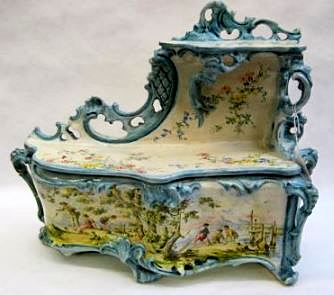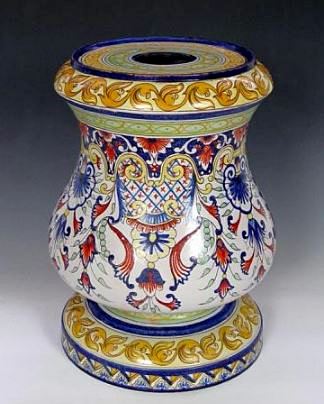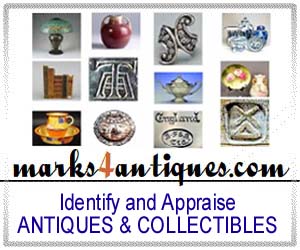FAIENCE POTTERY COLLECTIBLES:
A Fascinating Look into its Origins and History
See also: Quimper Pottery & French Faience

Faience pottery, also known as Fayence in France, is a type of earthenware that has been appreciated by collectors and enthusiasts for centuries. It's often used as a synonym for Majolica due to their similar appearance and use of tin glazes. However, Faience pottery is distinct in its characteristic polychrome (multi-colored) designs and mostly prevalently white background, while Majolica tends to have a thicker glaze and decoration all over along with pronounced raised decorative details (relief).
While the earliest specimens of Faience-decorated clayware date back to 1200BC in Greece and Persia, most antique Faience items found in the secondary market or museums today are made from the 16th century onwards, primarily in Italy, France, Holland, and the UK. The most desirable Faience pottery originates from France, particularly from the regions of Quimper, Ruen, Luneville, or from Italy near Turin, Cantagalli, Savona, and Florence. While some Faience pieces nowadays come from China and other Asian countries, recent reproductions are obviously not as valuable as authentic 16th - 19th-century examples.
Most antique Faience pottery had a quasi-utilitarian nature, such as jugs or pitchers and plates, but with a distinct aesthetic flair. Vases and other decorative ware were also made in the older days, but many tend to be of rather regular and ordinary shapes. Designs tend to be floral or geometric in nature, and some have simple depictions of pastoral scenes with one or two persons carrying farm duties, known as Bretons and Bretonnes, against an all-white background.

The vast majority of antique Faience was made in small studios or by individual artists, and these early pieces were signed with the artist's initials or monogram, along with a symbol or the full name of their location. Hence, Quimper or other names of regions where Faience Pottery was made do not reflect any actual manufacturer or maker, but rather a number of art studios or artists that worked in the area. Later, around the very-late-18th century onwards, some studios were much larger or became collectives, and some marks and signatures from that period are linked to a specific company, as in the case of the Henriot factory in Quimper, France.
Old Faience is highly sought-after today and can fetch high prices at auctions. Because early examples were made of earthenware and were of a utilitarian nature, many show clear signs of distress and wear, such as chips or cracks. However, this is to be expected, and in most cases, it does not detract from their value. In fact, some collectors believe it adds character to a Faience piece. This is unlike what you would expect from a Meissen porcelain figurine or a pair of Sevres urns that are usually more valuable if in perfect condition, even though they date from a similar period since the latter were meant to be used for display only.
In conclusion, Faience pottery is a fascinating and unique type of earthenware that has captured the hearts of collectors and enthusiasts for centuries. Its distinct characteristics and aesthetic appeal make it a must-have for any serious collector, and its history is a testament to the skill and creativity of the artists and studios that produced it. Whether you are a seasoned collector or a newcomer to the world of antique pottery, Faience is sure to impress and delight.
Unlock the true value
of your collection with our comprehensive research guides from identifying makers' marks to appraising all kinds of
antiques and collectibles.
Our up-to-date information will give you an accurate understanding of your items' worth. Don't miss out on this
valuable resource - visit our research tools today!
Search our price guide for your
own treasures





